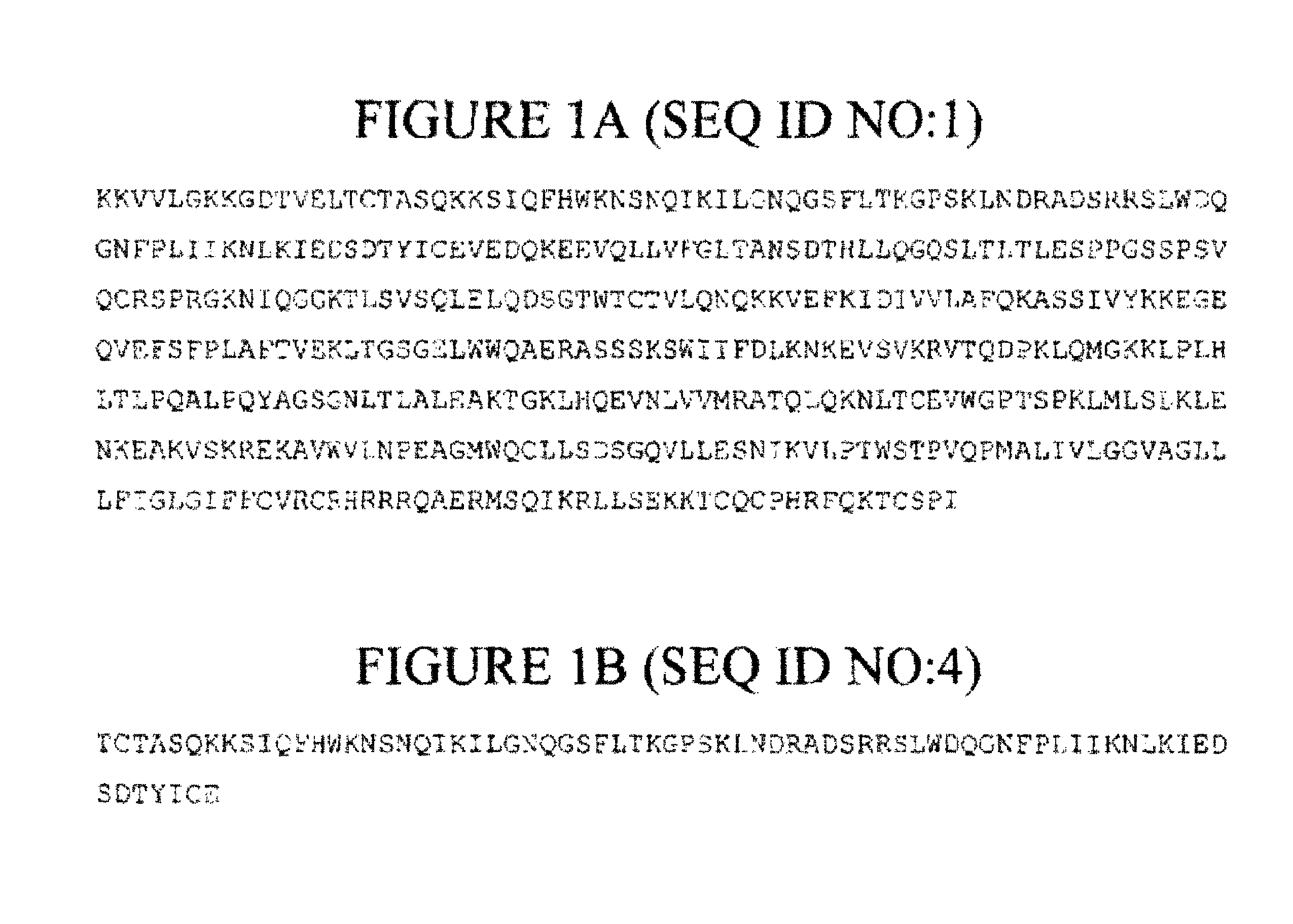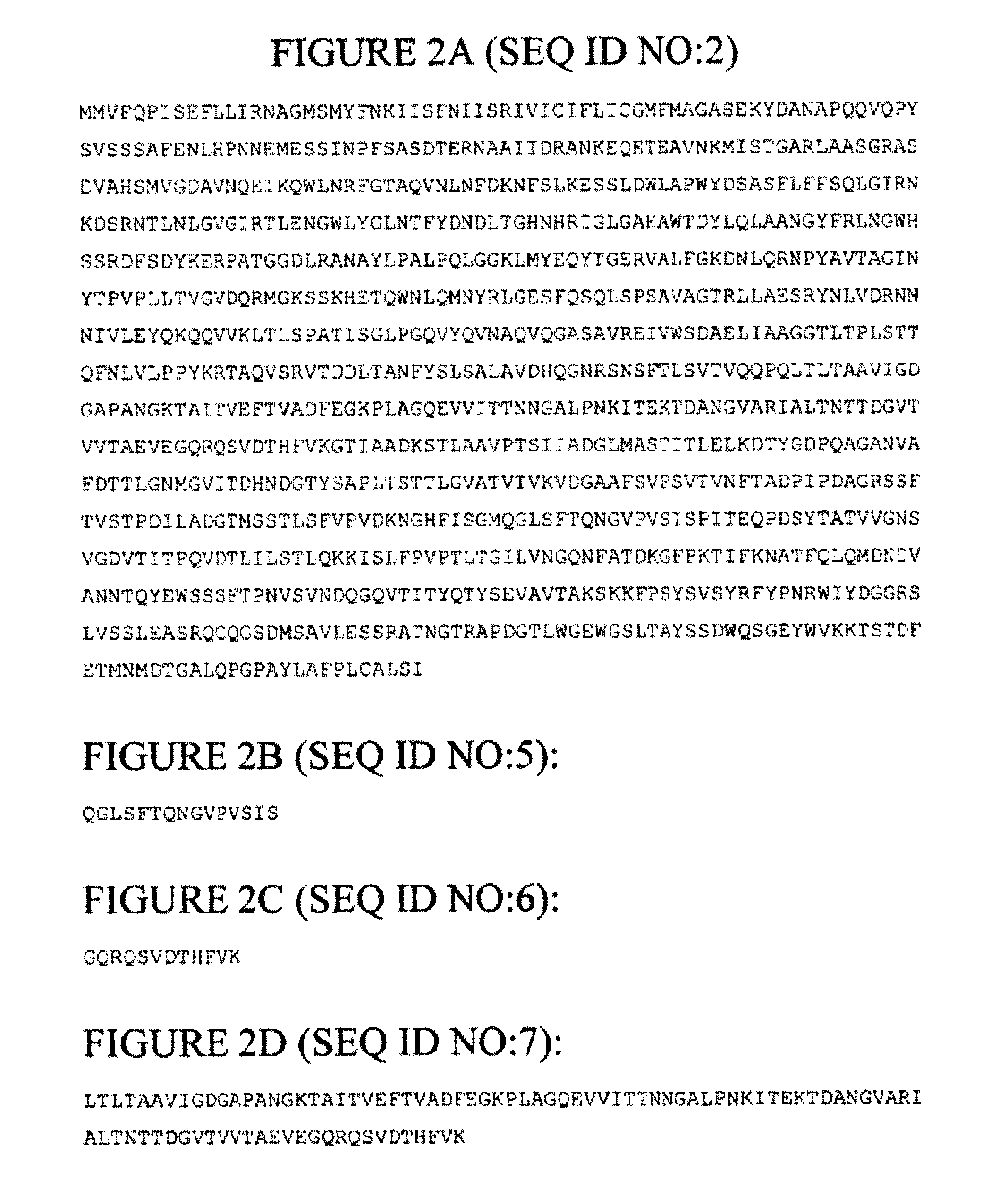Method for generating immune responses utilizing nucleic acids encoding fusion proteins comprising CD4 minimal modules and invasin polypeptides that are capable of binding to the HIV envelope and exposing cryptic neutralization epitopes
a technology of fusion proteins and nucleic acids, applied in the field of proteins, can solve the problems of general decline in the host immune system, inability to provide permanent antibodies, etc., and achieve the effect of reducing or eliminating unwanted immune responses
- Summary
- Abstract
- Description
- Claims
- Application Information
AI Technical Summary
Benefits of technology
Problems solved by technology
Method used
Image
Examples
example 1
Design of a Fusion Protein Comprising a CD4 Minimal Module
[0311]Novel fusion proteins comprising the gp120 binding region of human CD4 were designed as follows. The crystal structure of CD4-gp120 was analyzed and a region of CD4 involved in gp120 binding was identified, In particular, the region corresponding to amino acid residues 15-85 of CD4 is almost completely buried within the gp120-binding pocket (FIG. 4). This fragment was termed a CD4 minimal module and the fragment is stabilized by the presence of a disulfide bridge between Cys16 and Cys84.
[0312]Structural databases were searched for proteins having an overall configuration similar to CD4 in order to identify suitable structural scaffold into which CD4 minimal modules can be inserted to from fusion proteins. A total of 212 structures with structural similarity to native CD4 were identified. In order to minimize the risk of undesired autoimmunity, proteins from humans and primates, as well as proteins showing sequence simil...
example 2
Expression of Invasin-CD4 Fusion Proteins
[0321]Expression cassettes encoding invasin-CD4 fusion proteins shown in FIGS. 2G, 2H, 2I and 2J were expressed in E, coli. Three hours after induction with 1 mm IPTG, total cell lysate and soluble fractions were prepared and run on SDS-PAGE (4-12% MES) gels. The constructs shown in FIGS. 2H, 2I and 2J (SEQ ID NOs:11, 12 and 13, respectively) expressed proteins of the expected molecular weights in the soluble fraction.
[0322]Subsequently, expression cassettes encoding the invasin-CD4 fusion proteins shown in FIGS. 2H, 2I and 2J (SEQ ID NOs:11, 12 and 13, respectively) were expressed in bacteria (E. coli), grown to high density and inducted with 1 mM IPTG. Before induction, an uninduced sample was collected for evaluation. Following three hours of induction, cells were collected by centrifugation, lysed in lysis buffer and analyzed by SDS-PAGE / coomassie blue staining.
[0323]Proteins of the expected molecular weights were present in both induced ...
example 3
Binding Characteristics
[0325]The binding characteristics of various invasin-CD4 fusion molecules and complexes comprising these molecules were evaluated as follows.
[0326]A. Binding by CD4 Antibodies
[0327]Proteins expressed as described in Example 2 were subject to Western blotting using anti-CD4 monoclonal and polyclonal antibodies developed in-house. Briefly, different fractions of cell lysates and purified proteins (supernatant, pellet, flow through) were run on a standard SDS-PAGE gel and transferred to a nitrocellulose membrane. The members were probes with anti-CD4 monoclonals and polyclonal and the blot developed using commercially available anti-mouse and anti-rabbit IgG. Blots were scanned using Odyssey® Infrared Imaging System (LI-COR Biosciences).
[0328]The invasin-CD4 fusion proteins tested were not detectable using the anti-CD4 monoclonals and polyclonals used in these experiments.
[0329]B. Binding to gp120
[0330]Supernatants, containing the proteins expressed as described ...
PUM
| Property | Measurement | Unit |
|---|---|---|
| molecular weight | aaaaa | aaaaa |
| molecular weight | aaaaa | aaaaa |
| diameter | aaaaa | aaaaa |
Abstract
Description
Claims
Application Information
 Login to View More
Login to View More - R&D
- Intellectual Property
- Life Sciences
- Materials
- Tech Scout
- Unparalleled Data Quality
- Higher Quality Content
- 60% Fewer Hallucinations
Browse by: Latest US Patents, China's latest patents, Technical Efficacy Thesaurus, Application Domain, Technology Topic, Popular Technical Reports.
© 2025 PatSnap. All rights reserved.Legal|Privacy policy|Modern Slavery Act Transparency Statement|Sitemap|About US| Contact US: help@patsnap.com



